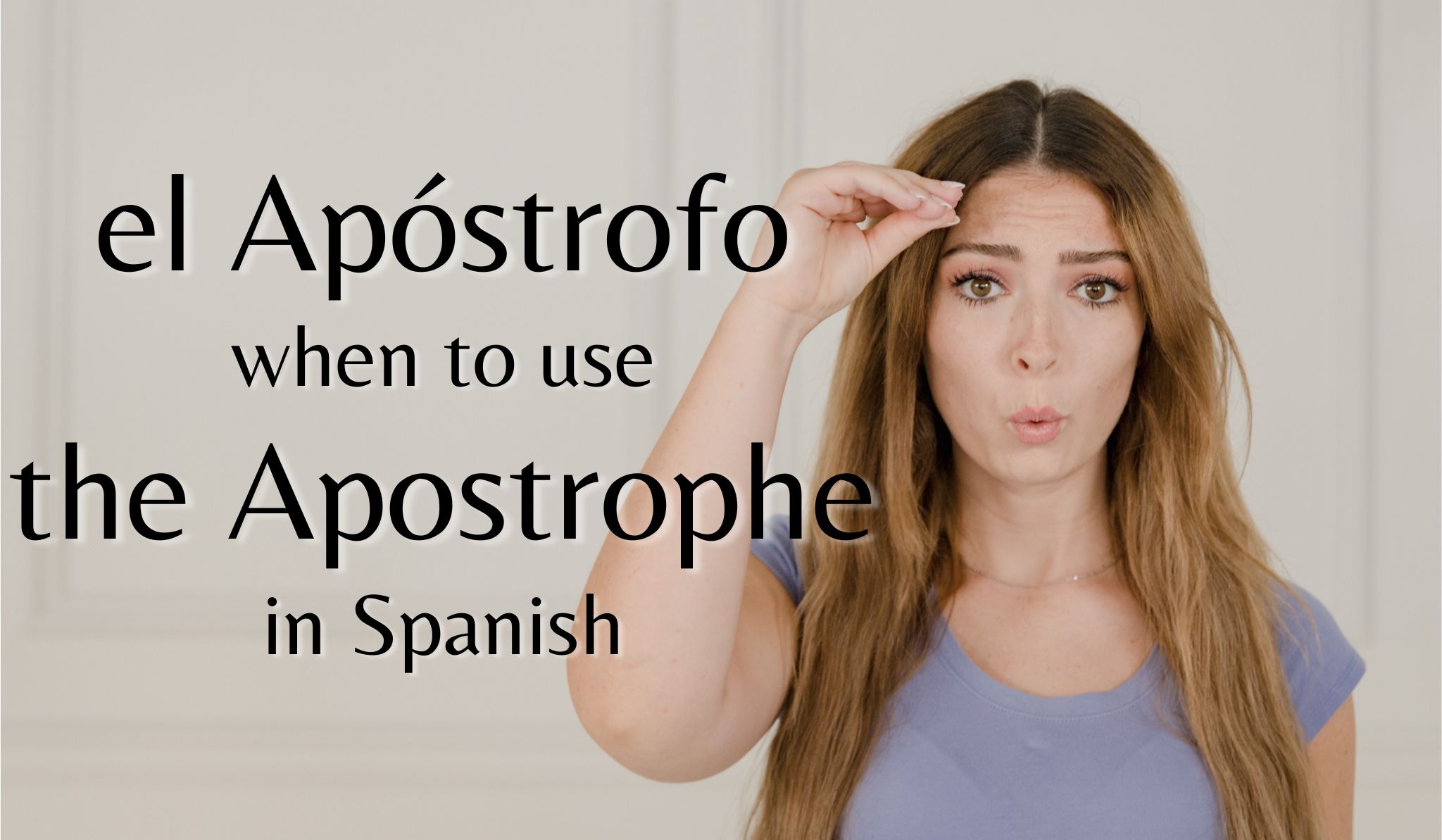Are there Apostrophes in Spanish: When to use El Apóstrofo

Get our free email course, Shortcut to Conversational.
Have conversations faster, understand people when they speak fast, and other tested tips to learn faster.
More infoThe apostrophe, known as el apóstrofo in Spanish, is a punctuation mark ( ’ ) which is not normally found in Spanish. Omnipresent in many languages such as English or French, the Spanish apóstrofo is only used in rare circumstances compared to those languages.
In today’s post, we’ll cover all that there is to know about the apostrophe in Spanish. We’ll begin by looking at its definition, and comparing its symbol with a few others that are almost identical. We’ll also clarify the difference between el apóstrofe and el apóstrofo in Spanish, as these two terms often cause confusion even among native Spanish speakers.
Then we’ll study in detail the instances where el apóstrofo is used in Spanish, both historically and in the contemporary language. As part of that analysis, we’ll look at some of the common uses (and misuses) of the apostrophe in Spanish today.
What Is an Apostrophe in Spanish?
The apostrophe is an orthographic sign that is used to shorten words by removing vowels and consonants. This mark indicates that one or many letters have been removed from a word. The Spanish term is el apóstrofo, a masculine noun.
El apóstrofo refers to a specific symbol used in writing, which English speakers know as an apostrophe. Spanish has a few other orthographic signs that look similar but have different lexical roles, so let’s make sure we’re clear on these.
| Symbol | Spanish name | English name |
| ’ | el apóstrofo | apostrophe |
| ‘ ’ | las comillas simples | single quotes |
| , ’ | la coma baja, la coma alta | low comma, high comma |
| ´ | el acento | acute accent |
Our post today will focus exclusively on el apóstrofo, which is used to link two words with no spaces before or after it.
Las comillas simples are a type of quotation mark in Spanish, always used in pairs at the start and end of the quoted phrase. Since Spanish uses angle quotes ( « » ), these simple quotation marks ( ‘ ’ ) are generally reserved for quoting something within a bigger quote.
La coma alta is a high counterpart to the comma that you know in English. Historically, its common use in Spanish was as the decimal point when writing numerals, or to separate hours and minutes when writing out the time. Both of these uses have essentially died out.
El acento is a Spanish accent mark that can be placed on vowels to indicate a stress. Since this symbol is found on Spanish keyboards and appears similar to an apostrophe, many Spanish speakers mistakenly insert un acento instead of the other symbols we’ve just looked at.
El Apóstrofo or el Apóstrofe?
Even many native Spanish speakers often wonder «¿apóstrofe o apóstrofo?», since it’s a common mistake to use these two words interchangeably. This is particularly the case for people who speak English and hear the similarity between the English apostrophe and the Spanish apóstrofe.
These are two very different words in Spanish! Let’s clear up the differences between apóstrofo vs apóstrofe.
Apóstrofo
El apóstrofo is a lexical mark, equivalent to an apostrophe in English. The focus of today’s post is on this apostrophe in Spanish.
Apóstrofe
El apóstrofe has nothing to do with punctuation, and actually has two different meanings.
Historically, un apóstrofe was a theatrical device whereby a character would interject with some dramatic lament in order to distract from the primary discourse.
Nowadays, un apóstrofe is more of an obscure term for an insult.
It should be noted, however, that neither of these (correct) uses are really used by contemporary Spanish speakers. The most common use of apóstrofe in Spanish today is the incorrect one, where it’s confused with apóstrofo. Now that you’re clear on the differences, you’re already ahead of many native speakers!
When to use the Apostrophe in Spanish
In reality, the apostrophe has very few uses in modern Spanish. It’s nonetheless present in the written language: some of these uses are considered acceptable by the Royal Spanish Academy, whereas others are less so.
Let’s start off with the contexts where we can correctly use an apostrophe in Spanish, and then look at the other contexts in the next section.
To quote spoken accents phonetically
Just like in English when you write spoken accents phonetically, we can do the same thing in Spanish. Think of a phrase like “Whatcha gonna do? I dunno.” and compare it with “What are you going to do? I don’t know.” You won’t find these phonetic words in the dictionary, but you know exactly what they mean when they’re read out loud, while also getting an idea of how the person speaks.
Likewise, in Latin America, the elision of certain sounds is a characteristic of some regional accents, while it can also tell us something about the social origin of the people who are speaking.
(Sidenote: Elision is the practice of phonetically combining words. We say that the words are elided.)
The general rule is that we can use an apostrophe in Spanish to link the two elided words into an informal contraction. The apostrophe replaces any letters that have been removed, and is placed directly between the words with no spaces. [For the following examples, we note the grammatically-correct forms in square brackets.]
- I’m here to help you. – Estoy aquí pa’yudarte. [para ayudarte]
- Mari went up from the house. – Mari fue pa’rriba de la casa. [para arriba]
- Let’s go ahead! I know we can do it! – ¡Vamos pa’lante, sé que podemos! [para adelante]
- The worker said to his boss “I’m not gonna go there”. – El peón le dijo a su patrón: “No voy a ir pa’ya”. [para allá]
- Luke is the son we’re looking for. – Lucas es el hijo que’tamos buscando. [estamos buscando]
- Did I tell you that I’m in love with you? – ¿Te dije que’toy enamorado de ti? [que estoy]
- Do you want lemon ice cream? – ¿Quieres helado’e limón? [helado de]
In historical poetic texts
Historically, as the Spanish language was evolving from its Latin roots, some of the same spelling practices were followed as are still seen in French, Italian, and Catalan. Hence, for some articles and prepositions that preceded a word beginning with a vowel, the final vowel would be dropped and the two words would be linked with an apóstrofo.
When we see historical texts today, we maintain their original spelling with the Spanish apostrophe.
- We had memories of that lost land. – Teníamos recuerdos d’aquella tierra perdida. [de aquella]
- If only you knew how beautiful you are! – ¡Si usted supiera lo bella qu’es! [que es]
When quoting names or phrases in other languages
In several languages, the use of apostrophes is very common. When we quote phrases or names from these foreign languages that contain apostrophes, we need to maintain los apóstrofos when writing them in Spanish.
- Do you like the song “Vent’anni,” from Månneskin’s second album, “Teatro d’ira: Vol. I”? – ¿Te gusta la canción «Vent’anni», del segundo álbum de Månneskin, «Teatro d’ira: Vol. I»?
- Before leaving she told me: “C’est la vie,” that’s life. – Antes de irse me dijo: «C’est la vie», así es la vida.
- Mr. O’Connor has come from Ireland to visit us. – El señor O’Connor ha venido a visitarnos desde Irlanda.
When to NOT use the Apostrophe in Spanish
We’ve just gone over the contexts where it’s considered acceptable to use the apostrophe in Spanish. In everyday circumstances, however, it is still fairly common to see several other contexts where the apostrophe is used in Spanish.
There can definitely be an argument for the evolution of the language, whereby a practice is eventually considered to be correct once it’s adopted by enough native speakers. For the Spanish language, the general arbiter of syntax and spelling is the Royal Spanish Academy, known by its Spanish acronym RAE.
In this section we’re presenting the contexts where the apóstrofo is commonly used, but which the RAE says to avoid. You’ll still likely come across some of these uses, whether by ordinary people or in the media, as they’re clearly taking hold in the language.
When mentioning acronyms in plural
Just as is often done by English speakers, Spanish speakers tend to pluralize acronyms adding ’s. In Spanish, however, the plural form of an acronym is expressed by using the plural article before the acronym, rather than modifying the acronym itself.
- Incorrect: Este sitio web enumera todas las ONG’s del mundo en un solo lugar.
- Correct: Este sitio web enumera todas las ONG del mundo en un solo lugar. – This website lists all the NGOs of the world in one place.
When referencing decades
Just like the example we just saw when pluralizing acronyms, the RAE also rules out the use of un apóstrofo to express decades. The plural article is adequate.
- Incorrect: Los 20’s fueron los años locos en los Estados Unidos de América.
- Correct: Los 20 fueron los años locos en los Estados Unidos de América. – The 20s were the roaring years in the United States of America.
For abbreviating years
In English, it’s very normal to use an apostrophe as a shorthand for years. This practice is becoming common in Spanish too. According to the RAE, the correct practice is to simply note the shorthand year with an article, and without an apostrophe.
- Incorrect: La promoción del ’19 fue la mejor.
- Correct: La promoción del 19 fue la mejor. – The ’19 prom was the best.
When separating numbers to express the hours
Some Spanish speakers tend to separate the hours and minutes with an apostrophe when writing out the time. Like in English, the colon is generally considered the correct syntax when telling time in Spanish.
- Incorrect: La función comienza a las 16’30 h.
- Correct: La función comienza a las 16:30 h. – The show starts at 4:30 pm.
Conclusion
So far so good! Today we’ve learned all that there is to know about the apostrophe in Spanish.
First we examined the apostrophe symbol in Spanish, along with several other symbols which appear quite similar. We also distinguished between the two similar words apóstrofe vs apóstrofo, which are frequently misused by native speakers. Now you are aware that un apóstrofe may be an insult, while un apóstrofo is the orthographic mark ( ’ ) that you know in English as an apostrophe.
Then we covered the cases where it’s considered correct to use the apostrophe in Spanish, providing plenty of examples for each use that you might read or hear. We also went over the other common contexts where the apostrophe is often used in Spanish, noting that the RAE recommends avoiding them.
With all these rules in mind, you’re now probably better versed in the correct use of apostrophes in Spanish than many native speakers!



